S9 (classification)
S8, SB8, SM8 are disability swimming classifications used for categorizing swimmers based on their level of disability. Swimmers in this class generally have severe weakness in one leg. This class includes a number of different disabilities including people with amputations and cerebral palsy. The classification is governed by the International Paralympic Committee, and competes at the Paralympic Games.
Definition
This classification is for swimming.[1] In the classification title, S represents Freestyle, Backstroke and Butterfly strokes. SB means breaststroke. SM means individual medley.[1] Jane Buckley, writing for the Sporting Wheelies, describes the swimmers in this classification as having: "severe weakness in one leg only; Swimmers with very slight coordination problems; Swimmers with one limb loss. Unless there is an underlying medical condition usually all of these athletes will start out of the water."[1] Swimming classifications are on a gradient, with one being the most severely physically impaired to ten having the least amount of physical disability.[2]
Disability types
This class includes people with several disability types include cerebral palsy and amputations.[3][4][5]
Amputee
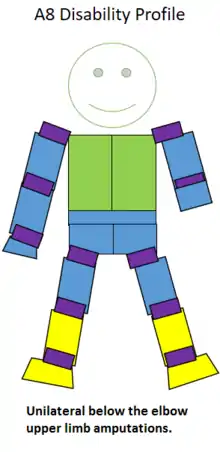
ISOD amputee A8 swimmers may be found in this class.[5] S9 amputee swimmers in this class have similar start times to people with legs amputations in S8 to S10 classes.[6] Paralympic S9 swimmers in this class can get water entry distance off the block comparable to Olympic athletes.[6] Compared to able bodied swimmers, swimmers in this class have a shorter stroke length and increased stroke rate.[6] Because their legs are their greatest strength, they modify their entry into the water to take advantage of this.[6]
The nature of a person's amputations in this class can effect their physiology and sports performance. Because they are missing a limb, amputees are more prone to overuse injuries in their remaining limbs. Common problems for intact upper limbs for people in this class include rotator cuffs tearing, shoulder impingement, epicondylitis and peripheral nerve entrapment.[7]
Cerebral palsy
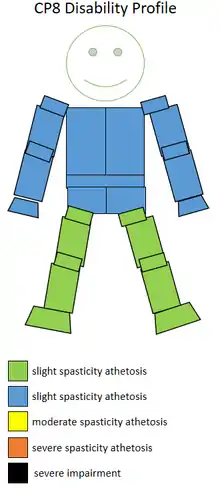
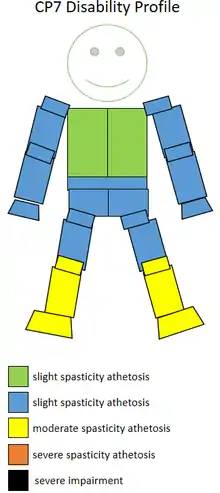
CP7 and CP8 class swimmers are sometimes found in this class.[3][4] CP7 sportspeople are able to walk, but appear to do so while having a limp as one side of their body is more affected than the other.[8][9][10][11] They may have involuntary muscles spasms on one side of their body.[10][11] They have fine motor control on their dominant side of the body, which can present as asymmetry when they are in motion.[10][12] People in this class tend to have energy expenditure similar to people without cerebral palsy.[13]
Because of the neuromuscular nature of their disability, CP7 and CP8 swimmers have slower start times than other people in their classes.[3] They are also more likely to interlock their hands when underwater in some strokes to prevent hand drift, which increases drag while swimming.[3] CP8 swimmers experience swimmers shoulder, a swimming related injury, at rates similar to their able-bodied counterparts.[3] When fatigued, asymmetry in their stroke becomes a problem for swimmers in this class.[3] The integrated classification system used for swimming, where swimmers with CP compete against those with other disabilities, is subject to criticisms has been that the nature of CP is that greater exertion leads to decreased dexterity and fine motor movements. This puts competitors with CP at a disadvantage when competing against people with amputations who do not lose coordination as a result of exertion.[14]
CP7 swimmers tend to have a passive normalized drag in the range of 0.6 to 0.8. This puts them into the passive drag band of PDB6, PDB8, and PDB9.[15] CP8 swimmers tend to have a passive normalized drag in the range of 0.4 to 0.9. This puts them into the passive drag band of PDB6, PDB8, and PDB10.[16]
Spinal cord injuries
People with spinal cord injuries compete in this class, including F8 sportspeople.[17][18][19]
F8
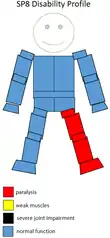
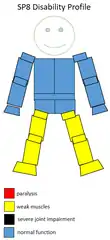
F8 is standing wheelchair sport class.[20][21] The level of spinal cord injury for this class involves people who have incomplete lesions at a slightly higher level. This means they can sometimes bear weight on their legs.[22] In 2002, USA Track & Field defined this class as, "These are standing athletes with dynamic standing balance. Able to recover in standing when balance is challenged. Not more than 70 points in legs."[23] In 2003, Disabled Sports USA defined this class as, "In a sitting class but not more than 70 points in the lower limbs. Are unable to recover balance in challenged standing position."[20] In Australia, this class means combined lower plus upper limb functional problems. "Minimal disability."[24] It can also mean in Australia that the athlete is "ambulant with moderately reduced function in one or both lower limbs."[24] They have a normalized drag in the range of 0.6 to 0.7.[25]
History
The classification was created by the International Paralympic Committee and has roots in a 2003 attempt to address "the overall objective to support and co-ordinate the ongoing development of accurate, reliable, consistent and credible sport focused classification systems and their implementation."[26] In 1997, Against the odds : New Zealand Paralympians said this classification was graded along a gradient, with S1 being the most disabled and S10 being the least disabled. At this time, competitors who were S9 classified tended to be above the elbow or above the knee amputees.[27]
Competitions
For this classification, organisers of the Paralympic Games have the option of including the following events on the Paralympic programme: 50m and 100m Freestyle, 400m Freestyle, 100m Backstroke, 100m Butterfly, 100m Breaststroke and 200m Individual Medley events[28]
Records
In the S9 50 m Freestyle Long Course, the men's world record is held by Australia's Matthew Cowdrey and the women's world record is held by South Africa's Natalie Du Toit.[29] In the S9 100 m Freestyle Long Course, the men's world record is held by Australia's Rowan Crothers and the women's world record is held by South Africa's Natalie Du Toit.[30]
Paralympic records
The table below records the fastest ever Paralympic record in this class for specific events.
| Event | Class | Time | Name | Nation | Date | Games | Ref | ||
|---|---|---|---|---|---|---|---|---|---|
| 50 m freestyle | S9 | 25.34 | WR | Matthew John Cowdrey | Sep 14, 2008 | 2008 Beijing | [31] | ||
| 100 m freestyle | S9 | 54.58 | WR | Rowan Crothers | July 24, 2014 | 2014 Glasgow | [32] | ||
| 400 m freestyle | S9 | 4:17.02 | WR | Jesus Collado | Sep 12, 2008 | 2008 Beijing | [33] | ||
| 100 m backstroke | S9 | 1:03.34 | WR | Matthew John Cowdrey | Sep 13, 2008 | 2008 Beijing | [34] | ||
| 100 m butterfly | S9 | 57.19 | WR | William Martin | Sep 2, 2021 | 2020 Tokyo | [35] |
Records not set in finals: h – heat; r – relay 1st leg; rh – relay heat 1st leg
Getting classified
Classification generally has four phases. The first stage of classification is a health examination. For amputees in this class, this is often done on site at a sports training facility or competition. The second stage is observation in practice, the third stage is observation in competition and the last stage is assigning the sportsperson to a relevant class.[36] Sometimes the health examination may not be done on site for amputees in this class because the nature of the amputation could cause not physically visible alterations to the body.[37]
In Australia, to be classified in this category, athletes contact the Australian Paralympic Committee or their state swimming governing body.[38] In the United States, classification is handled by the United States Paralympic Committee on a national level. The classification test has three components: "a bench test, a water test, observation during competition."[39] American swimmers are assessed by four people: a medical classified, two general classified and a technical classifier.[39]
Competitors

Swimmers who have competed in this classification include Ellie Cole,[40] Jesus Collado[40] and Matthew Cowdrey[40] who all won medals in their class at the 2008 Paralympics.[40]
American swimmers who have been classified by the United States Paralympic Committee as being in this class include Dana Albrycht, Luis Alicea, Hannah Aspden, Cody Bureau, Michael Prout Jr., David Gelfand, Joseph Peppersack, and Staci Perrige.[41]
References
- Buckley, Jane (2011). "Understanding Classification: A Guide to the Classification Systems used in Paralympic Sports". Archived from the original on 11 April 2011. Retrieved 12 November 2011.
- Shackell, James (2012-07-24). "Paralympic dreams: Croydon Hills teen a hotshot in pool". Maroondah Weekly. Archived from the original on 2012-12-04. Retrieved 2012-08-01.
- Scott, Riewald; Scott, Rodeo (2015-06-01). Science of Swimming Faster. Human Kinetics. ISBN 9780736095716.
- Tim-Taek, Oh; Osborough, Conor; Burkett, Brendan; Payton, Carl (2015). "Consideration of Passive Drag in IPC Swimming Classification System" (PDF). VISTA Conference. International Paralympic Committee. Retrieved July 24, 2016.
- Tim-Taek, Oh; Osborough, Conor; Burkett, Brendan; Payton, Carl (2015). "Consideration of Passive Drag in IPC Swimming Classification System" (PDF). VISTA Conference. International Paralympic Committee. Retrieved July 24, 2016.
- Vanlandewijck, Yves C.; Thompson, Walter R. (2011-07-13). Handbook of Sports Medicine and Science, The Paralympic Athlete. John Wiley & Sons. ISBN 9781444348286.
- Miller, Mark D.; Thompson, Stephen R. (2014-04-04). DeLee & Drez's Orthopaedic Sports Medicine. Elsevier Health Sciences. ISBN 9781455742219.
- "CLASSIFICATION SYSTEM FOR STUDENTS WITH A DISABILITY". Queensland Sport. Queensland Sport. Archived from the original on April 4, 2015. Retrieved July 23, 2016.
- "Classification Made Easy" (PDF). Sportability British Columbia. Sportability British Columbia. July 2011. Retrieved July 23, 2016.
- "Clasificaciones de Ciclismo" (PDF). Comisión Nacional de Cultura Física y Deporte (in Mexican Spanish). Mexico: Comisión Nacional de Cultura Física y Deporte. Retrieved July 23, 2016.
- "Kategorie postižení handicapovaných sportovců". Tyden (in Czech). September 12, 2008. Retrieved July 23, 2016.
- Cashman, Richmard; Darcy, Simon (2008-01-01). Benchmark Games. Benchmark Games. ISBN 9781876718053.
- Broad, Elizabeth (2014-02-06). Sports Nutrition for Paralympic Athletes. CRC Press. ISBN 9781466507562.
- Richter, Kenneth J.; Adams-Mushett, Carol; Ferrara, Michael S.; McCann, B. Cairbre (1992). "llntegrated Swimming Classification : A Faulted System" (PDF). Adapted Physical Activity Quarterly. 9: 5–13. doi:10.1123/apaq.9.1.5.
- Tim-Taek, Oh; Osborough, Conor; Burkett, Brendan; Payton, Carl (2015). "Consideration of Passive Drag in IPC Swimming Classification System" (PDF). VISTA Conference. International Paralympic Committee. Retrieved July 24, 2016.
- Tim-Taek, Oh; Osborough, Conor; Burkett, Brendan; Payton, Carl (2015). "Consideration of Passive Drag in IPC Swimming Classification System" (PDF). VISTA Conference. International Paralympic Committee. Retrieved July 24, 2016.
- International Paralympic Committee (February 2005). "SWIMMING CLASSIFICATION CLASSIFICATION MANUAL" (PDF). International Paralympic Committee Classification Manual. Archived from the original (PDF) on 2016-11-04.
- Winnick, Joseph P. (2011-01-01). Adapted Physical Education and Sport. Human Kinetics. ISBN 9780736089180.
- Tim-Taek, Oh; Osborough, Conor; Burkett, Brendan; Payton, Carl (2015). "Consideration of Passive Drag in IPC Swimming Classification System" (PDF). VISTA Conference. International Paralympic Committee. Retrieved July 24, 2016.
- National Governing Body for Athletics of Wheelchair Sports, USA. Chapter 2: Competition Rules for Athletics. United States: Wheelchair Sports, USA. 2003.
- Consejo Superior de Deportes (2011). Deportistas sin Adjectivos (PDF) (in European Spanish). Spain: Consejo Superior de Deportes. Archived from the original (PDF) on 2016-11-04. Retrieved 2016-08-03.
- Foster, Mikayla; Loveridge, Kyle; Turley, Cami (2013). "S P I N A L C ORD I N JURY" (PDF). Therapeutic Recreation.
- "SPECIAL SECTION ADAPTATIONS TO USA TRACK & FIELD RULES OF COMPETITION FOR INDIVIDUALS WITH DISABILITIES" (PDF). USA Track & Field. USA Track & Field. 2002.
- Sydney East PSSA (2016). "Para-Athlete (AWD) entry form – NSW PSSA Track & Field". New South Wales Department of Sports. New South Wales Department of Sports. Archived from the original on 2016-09-28.
- Tim-Taek, Oh; Osborough, Conor; Burkett, Brendan; Payton, Carl (2015). "Consideration of Passive Drag in IPC Swimming Classification System" (PDF). VISTA Conference. International Paralympic Committee. Retrieved July 24, 2016.
- "Paralympic Classification Today". International Paralympic Committee. 22 April 2010. p. 3.
{{cite web}}: Missing or empty|url=(help) - Gray, Alison (1997). Against the odds : New Zealand Paralympians. Auckland, N.Z.: Hodder Moa Beckett. p. 18. ISBN 1869585666. OCLC 154294284.
- "Swimming Classification". The Beijing Organizing Committee for the Games of the XXIX Olympiad. 2008. Archived from the original on 14 March 2012. Retrieved 18 November 2011.
- "IPC Swimming World Records Long Course". International Paralympic Committee. Archived from the original on 19 May 2012. Retrieved 18 November 2011.
- "IPC Swimming World Records Long Course". International Paralympic Committee. Archived from the original on 19 May 2012. Retrieved 18 November 2011.
- "Beijing 2008 Paralympic Games - Men's 50m freestyle - S9: Results Final" (PDF). Beijing Organizing Committee for the Olympic Games. 2008-09-14. Retrieved 2008-08-15.
- "Beijing 2008 Paralympic Games - Men's 100m freestyle - S9: Results Final" (PDF). Beijing Organizing Committee for the Olympic Games. 2008-09-08. Archived from the original (PDF) on 2008-09-11. Retrieved 2008-09-11.
- "Beijing 2008 Paralympic Games - Men's 400m freestyle - S9: Results Final" (PDF). Beijing Organizing Committee for the Olympic Games. 2008-09-12. Retrieved 2008-09-12.
- "Beijing 2008 Paralympic Games - Men's 100m backstroke - S9: Results Final" (PDF). Beijing Organizing Committee for the Olympic Games. 2008-09-13. Retrieved 2008-09-15.
- "Beijing 2008 Paralympic Games - Men's 100m butterfly - S9: Results Final" (PDF). Beijing Organizing Committee for the Olympic Games. 2008-09-07. Archived from the original on 2008-09-10. Retrieved 2008-09-11.
- Tweedy, Sean M.; Beckman, Emma M.; Connick, Mark J. (August 2014). "Paralympic Classification: Conceptual Basis, Current Methods, and Research Update". Paralympic Sports Medicine and Science. 6 (85): S11-7. doi:10.1016/j.pmrj.2014.04.013. PMID 25134747. S2CID 207403462. Retrieved July 25, 2016.
- Gilbert, Keith; Schantz, Otto J.; Schantz, Otto (2008-01-01). The Paralympic Games: Empowerment Or Side Show?. Meyer & Meyer Verlag. ISBN 9781841262659.
- "Classification Information Sheet" (PDF). Australian Paralympic Committee. 8 March 2011. p. 3. Retrieved 17 November 2011.
- "U.S. Paralympics National Classification Policies & Procedures SWIMMING". United States Paralympic Committee. 26 June 2011. Retrieved 18 November 2011.
- "Results". International Paralympic Committee. Retrieved 18 November 2011.
- "USA NATIONAL CLASSIFICATION DATABASE" (PDF). United States Paralympic Committee. 7 October 2011. Retrieved 18 November 2011.
.svg.png.webp)
.svg.png.webp)